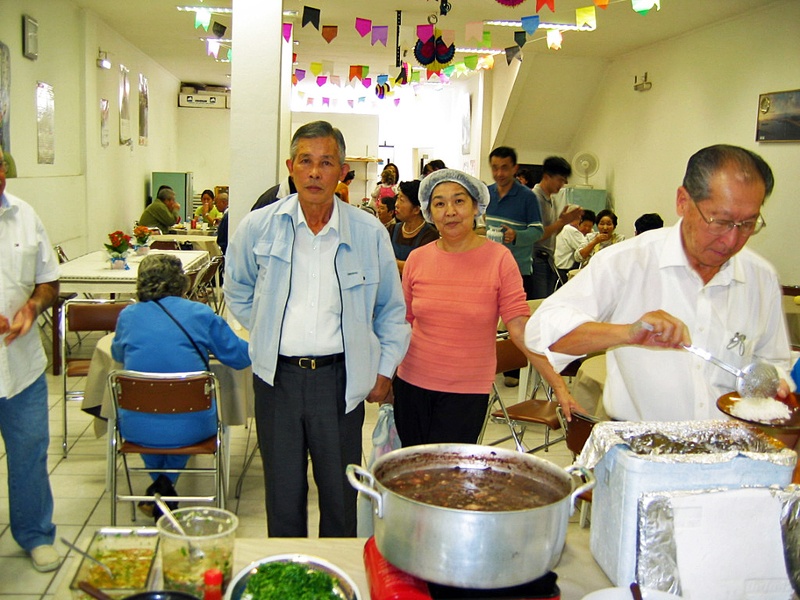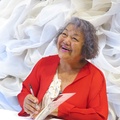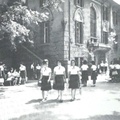“I enjoyed it for the first time in three years.” In June, 2005, Makoto Oka, (age 66 at the time) chairperson of Brazil Okayama Kenjinkai (prefectural association) commented on the feijoada, a major Brazilian dish, with a face that showed his getting over some past woe.
As a matter of fact, Oka almost died from a burn on his body when he turned over a giant pot of feijoada at the kenjinkai hall in the past.
Feijoada, a local cuisine representative of Brazil, is a dish that is cooked with black beans stewed with ingredients such as cow ears and dried meat. Fat and gelatin from meat are run into the thick soup of softened black beans and with mandioca powder on top, this rich-flavored dish is eaten with rice.
For some reason, feijoada is typically cooked on Saturdays and is often mistaken for “zenzai” (sweet red bean soup) by Japanese people who just arrived in Brazil. But of course the first sip is enough to surprise them with its salty taste.
Feijoada served at Brazil Okayama Kenjinkai has its appeal in the cooking process in which the ingredients are simmered beforehand to remove oil and stewed thoroughly with less salt to get the flavor more familiar to the Japanese taste.
* * * * *
Three years before, on June 8 in 2002, around 6:30 p.m. on Saturday, the women’s club had finished preparing two pots of feijoada for the traditional event at kenjinkai, the Feijoada Gathering which was planned to be held the following day, and they were resting on the second floor.
In the kitchen on the first floor, chairperson Oka was alone watching the stove. Dazedly starting at the stove, he noticed that, with broken ballast, a fluorescent at the back had burned out. Why don’t I fix it? - he hopped on a four-legged stool.
To replace the ballast, he had to cut the cord, but he couldn’t find the pliers in the usual place, unluckily on the day that he needed it.
Looking down on the giant pot from the four-legged stool, he thought that he could simply rip the cord by pulling it hard, and he pulled it with all his strength.
Then there was a huge noise. Crash! It was the noise of chairperson Oka, holding the ballast, falling into the boiling pot and over all together.
Ahhhhhhhhhhhh! Hearing the scream, people in the women’s club rushed to the scene and took him to the hospital.
After examining his body, the doctor told his family calmly. “I’m sorry but he probably won’t make it.” It meant his life was ending.
In fact, 40% of his body skin suffered from a second- to third-degree burn. His entire body was wrapped in bandage gauze, and he was lying on the bed with his face out, the only part that was not covered.
“My face was swollen to this size,” Oka gestured a size of a soccer ball.
“Sogura (his wife’s mother) came to visit me, but she went to the room next door because she couldn’t recognize my face.” Three years of time since the incident enabled him to talk about the experience with a laugh, but at that time it was no joke.
While in the hospital, it took him 3.5 to 4 hours just to change his gauze every day. As Oka recalled, “The changing of gauze ripped my skin off and made it bleed. It’s a kind of pain that only those who went through it would understand.” His pain-killers eventually stopped working, and he had to use morphine in the maximum amount that was allowed.
But a month later, he was able to leave the hospital. The doctor was surprised how much he had recovered. His wife Mieko (age 52 at the time, from Okayama Prefecture) recalled, “I feel really sorry about making people worry so much.” Some people even flew from Japan just to see him, hearing that he might not make it.
The gathering of feijoada had been a traditional event for over a decade, but since the incident no one even mentioned a word of it, according to a member of the kenjinkai. People worried so much about the possibility of another accident, even though the chance was probably one in a million.
Seeing everyone concerned about such possibilities, in the beginning of 2005, Oka himself decided to make the first move. “We need to get the spirit back. No accident will happen if we are careful. We have to hold the event as a trigger,” he encouraged people to bring the gathering back.
There’s no reason to do it with such risk. Some people opposed. But chairperson Oka was determined.
Yet in the back of his mind he was nervous. “I wouldn’t have had the energy last year,” he said. In fact, in April, 2005, he just had a surgery to remove a keloid from his belly. “My doctor just told me I could eat meat of four-legged animals once a month. Just in time for this gathering,” he laughed.
On June 26, 2005, shortly after 2 p.m., 300 dishes they’d prepared were all sold out, and this time he had a scream of joy.
“How was the taste after three years?” When a reporter asked him gingerly, Oka answered sincerely with a smile. “It was special, since the women’s club put their heart in it. I enjoyed it.”
The courage that overcame his own taboo helped facilitate kenjinkai activities. “I’m hoping that this would boost morale.” He looked relieved that the dishes were sold out.
The revival of feijoada provided all members with a special taste.
To begin with, chairperson himself overcame his painfully traumatic experience and convinced board members and others. “To bring the spirit back to kenjinkai, we renamed the gathering ‘Momotaro (peach boy) feijoada’ from this time.” It was the beginning of a promising drama of revival.
* * * * *
Oka moved to Brazil in 1958 as the first-year trainee of Higashiyama Farm. Upon completion of his training, he worked at the farm and ran his own business of fixing and selling agricultural machinery. During about ten years of his term as chairperson of kenjinkai, he actively supported students who came from Japan under prefectural expenditure. Even after his term as chairperson, he put his heart in promoting kenjinkai as chairperson emeritus.
On May 26, 2015, he passed away from Parkinson’s disease and some other factors in a hospital in the city of São Paulo. He was 76.
Of course, “Momotaro Feijoada” is still held to this day.
© 2017 Fukasawa Masayuki







